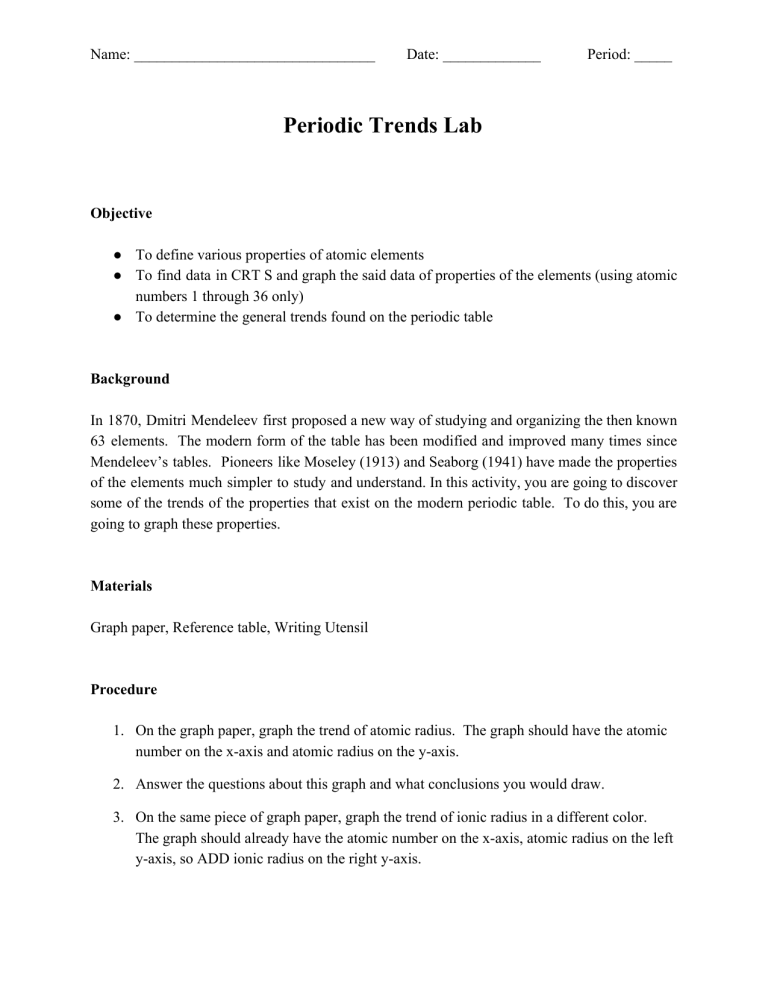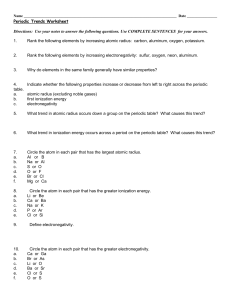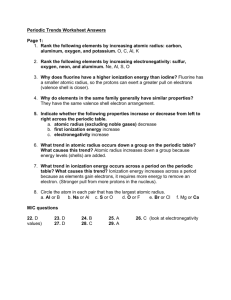
Name: ________________________________ Date: _____________ Period: _____ Periodic Trends Lab Objective ● To define various properties of atomic elements ● To find data in CRT S and graph the said data of properties of the elements (using atomic numbers 1 through 36 only) ● To determine the general trends found on the periodic table Background In 1870, Dmitri Mendeleev first proposed a new way of studying and organizing the then known 63 elements. The modern form of the table has been modified and improved many times since Mendeleev’s tables. Pioneers like Moseley (1913) and Seaborg (1941) have made the properties of the elements much simpler to study and understand. In this activity, you are going to discover some of the trends of the properties that exist on the modern periodic table. To do this, you are going to graph these properties. Materials Graph paper, Reference table, Writing Utensil Procedure 1. On the graph paper, graph the trend of atomic radius. The graph should have the atomic number on the x-axis and atomic radius on the y-axis. 2. Answer the questions about this graph and what conclusions you would draw. 3. On the same piece of graph paper, graph the trend of ionic radius in a different color. The graph should already have the atomic number on the x-axis, atomic radius on the left y-axis, so ADD ionic radius on the right y-axis. Name: ________________________________ Date: _____________ Period: _____ 4. Answer the questions about this graph and what conclusions you would draw. 5. On the second graph paper, graph the trend of first ionization energy (potential). The graph should have the atomic number on the x-axis and ionization energy on the y-axis. 6. Answer the questions about this graph and what conclusions you would draw. 7. On the third graph paper, graph the trend of electronegativity. The graph should have the atomic number on the x-axis and electronegativity on the y-axis. 8. Answer the questions about this graph and what conclusions you would draw. Data Analysis & Post-lab Questions Periodic Trends Arrows Name: ________________________________ Date: _____________ Period: _____ Atomic Radius 1. Create the graph as described in the procedure. 2. Define atomic radius. 3. What is the trend as you move down a group (column)? 4. What is the trend as you move across a period (row)? 5. On the representation of the periodic table above, draw arrows to represent an increasing atomic radius. Ionic Radius 1. Create the graph as described in the procedure. 2. Define ionic radius. 3. Describe the trend as you move down a group (column)? 4. Describe the trend as you move across a period (row)? 5. On the representation of the periodic table above, draw arrows to represent an increasing ionic radius. Name: ________________________________ Date: _____________ Period: _____ Ionization Energy 1. 2. 3. 4. 5. Create the graph as described in the procedure. Define ionization energy. Describe the trend as you move down a group (column)? Describe the trend as you move across a period (row)? On the representation of the periodic table above, draw arrows to represent increasing first ionization energy. Name: ________________________________ Date: _____________ Period: _____ Electronegativity 1. 2. 3. 4. 5. Create the graph as described in the procedure. Define electronegativity. Describe the trend as you move down a group (column)? Describe the trend as you move across a period (row)? On the representation of the periodic table above, draw arrows to represent an increasing electronegativity. Regents Practice Questions 1. When an atom loses an electron, what is its charge? What do you think happens to the size of the atom? 2. When an atom gains an electron, what is its charge? What do you think happens to the size of the atom? 3. Arrange the following atoms in order of increasing atomic radius: potassium, carbon, rubidium, iodine, fluorine, and lithium. Explain your order. 4. Arrange the following atoms in order of increasing ionization energy: lithium, oxygen, magnesium, strontium, chlorine, and tellurium. Explain your order. Name: ________________________________ Date: _____________ Period: _____ 5. A metal, M, was obtained from a compound in a rock sample. Experiments have determined that the element is a member of Group 2 on the Periodic Table of Elements. Explain why the radius of a positive ion of element M is smaller than the radius of an atom of element M. 6. As atomic number increases within Group 15 on the Periodic Table, atomic radius a. decreases, only b. increases, only c. decreases, then increases d. increases, then decreases 7. Which general trend is demonstrated by the Group 17 elements as they are considered in order from top to bottom on the Periodic Table? a. a decrease in atomic radius b. a decrease in electronegativity c. an increase in first ionization energy d. an increase in nonmetallic behavior 8. In the ground state, each atom of an element has two valence electrons. This element has lower first ionization energy than calcium. Where is this element located on the Periodic Table? a. Group 1, Period 4 b. Group 2, Period 5 c. Group 2, Period 3 d. Group 3, Period 4 9. Using the table below, explain in terms of atomic structure why cesium has lower first ionization energy than rubidium.

